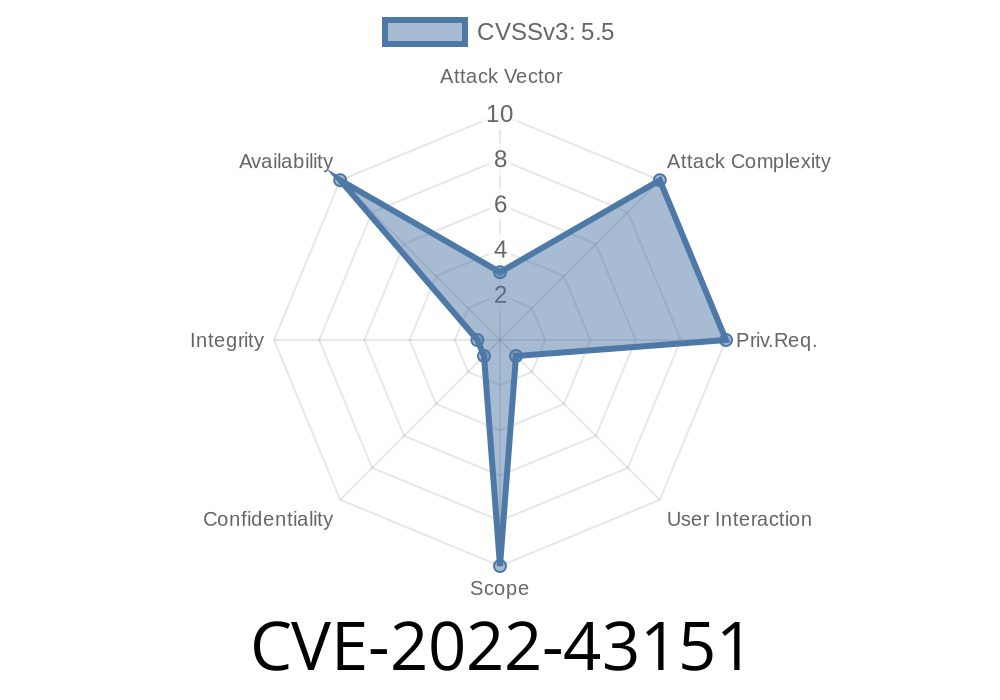The purpose of this long-read post is to delve into the details of the memory leak found in the timg v1.4.4 package, specifically through the timg::QueryBackgroundColor() function, as reported under the Common Vulnerabilities and Exposures (CVE) reference CVE-2022-43151. We'll provide an overview of the vulnerability, illustrate code snippets showcasing the issue, provide links to original references and resources, and discuss possible exploitation scenarios.
Overview
timg is a versatile terminal image viewer that provides advanced rendering capabilities for images and animations. Version 1.4.4 of timg was discovered to contain a memory leak via the function timg::QueryBackgroundColor() at /timg/src/term-query.cc. A memory leak occurs when a computer program consumes memory, but fails to release it back to the operating system when it's no longer needed. Prolonged memory leaks can lead to performance degradation, crashes, and security vulnerabilities, as they can be exploited by attackers to gain unauthorized access to a system or trigger denial-of-service (DoS) conditions.
Code Snippet
The memory leak found in the function timg::QueryBackgroundColor() within the file /timg/src/term-query.cc is illustrated in the following code snippet:
std::string QueryBackgroundColor(Terminal *term) {
PrintDebug("Requesting background color");
// Send command to query background color
term->Print("%s", kBcQuerySequence);
term->Flush();
// Read response
std::string response;
for (bool quit = false; !quit;) {
// Read one byte at a time, with a timeout
char buf;
if (term->Read(&buf, 1, /*timeout_ms=*/kBackgroundColorTimeoutMs) != 1) {
PrintDebug("Timeout waiting for BG response");
break;
}
response += buf;
// Check for terminating character '~'
quit = (buf == kBackgroundColorEndChar);
}
return response;
}
In this code snippet, we can observe that the function queries the background color from the terminal. It sends the command kBcQuerySequence, flushes the terminal buffer, and then reads the response by reading one byte at a time in a loop. The loop is terminated by the character '~'.
The memory leak occurs within this loop where the response variable keeps appending to itself indefinitely, leading to an increase in memory allocation. The memory allocated to the response variable is not de-allocated, resulting in a memory leak.
Here are some original references and resources related to the discovered vulnerability
1. timg Git Repository: The official GitHub repository for the timg project. You can clone the repository and examine the source code, including the affected file /timg/src/term-query.cc.
2. CVE-2022-43151 Record at NIST: The official record for this CVE at the National Vulnerability Database (NVD), maintained by the National Institute of Standards and Technology (NIST). The record provides an overview of the vulnerability, as well as a CVSS severity rating and assigned scores.
3. timg Project Homepage: The homepage for the timg project, where you can find the latest news, documentation, and use cases.
The exploitation of a memory leak vulnerability often follows a two-step approach
1. Trigger the vulnerability: By repeatedly making use of the affected timg::QueryBackgroundColor() function or by sending crafted input that causes the function to leak memory, an attacker may cause the timg process's memory usage to grow uncontrollably. This can adversely affect the performance of the system, leading to crashes or other unintended consequences.
2. Exploit the vulnerability: Once the memory leak is triggered and memory usage has increased, an attacker may attempt to gain unauthorized access to a system or trigger DoS conditions by exploiting the memory leak.
To mitigate the risk of exploitation, developers should consider patching the vulnerable code by introducing proper memory management techniques, such as deallocating the memory allocated to the response variable in the timg::QueryBackgroundColor() function.
Conclusion
The discovered memory leak in timg v1.4.4 poses a potential security risk, as its exploitation may lead to unauthorized access or denial of service conditions. Developers, administrators, and end-users should be aware of this vulnerability and patch their systems accordingly, applying proper memory management techniques to eliminate the memory leak from the affected timg::QueryBackgroundColor() function.
Timeline
Published on: 10/31/2022 19:15:00 UTC
Last modified on: 11/02/2022 00:16:00 UTC
